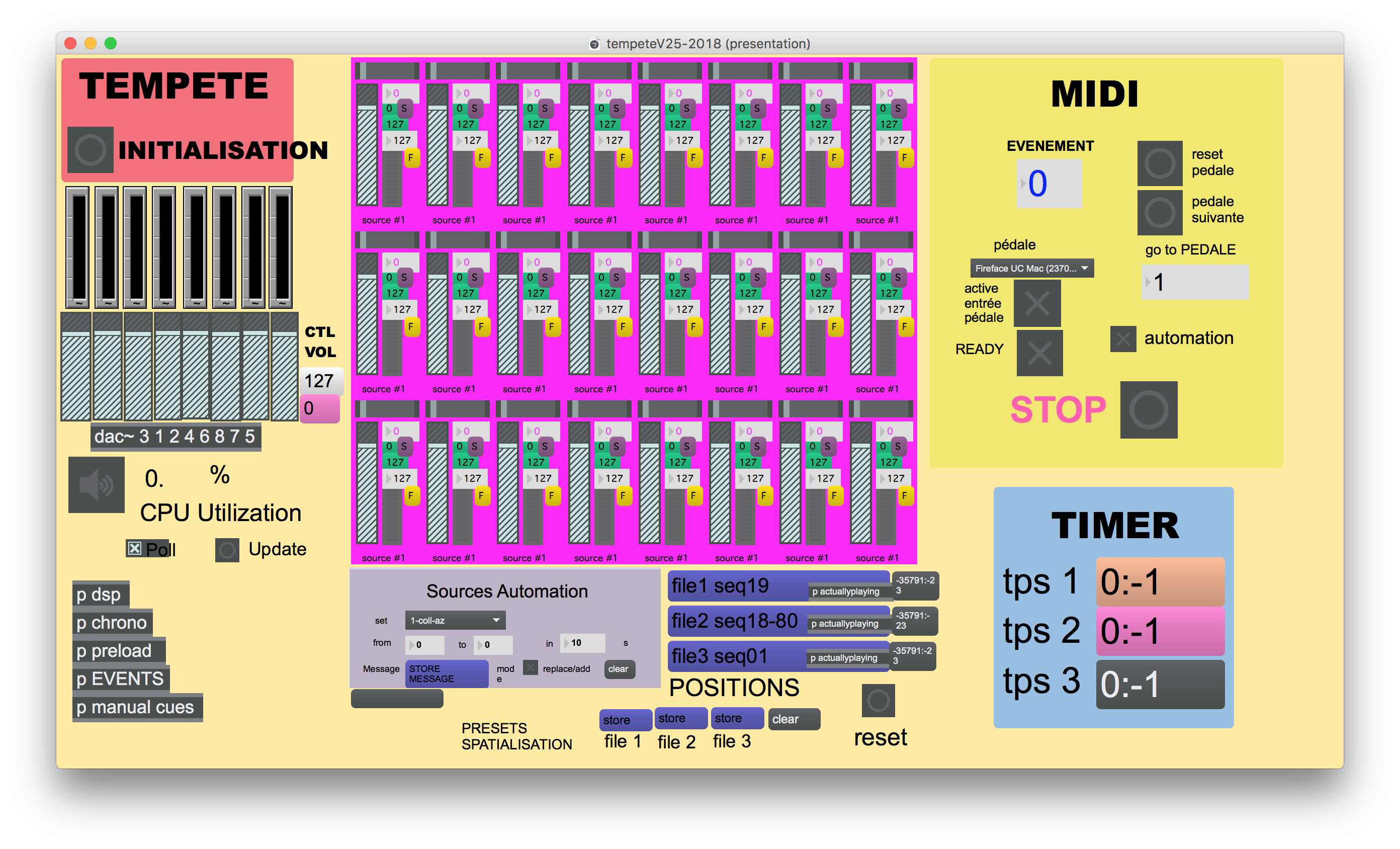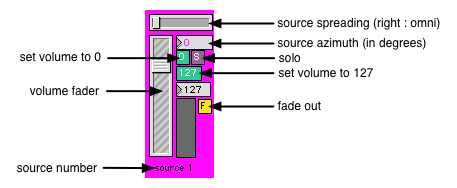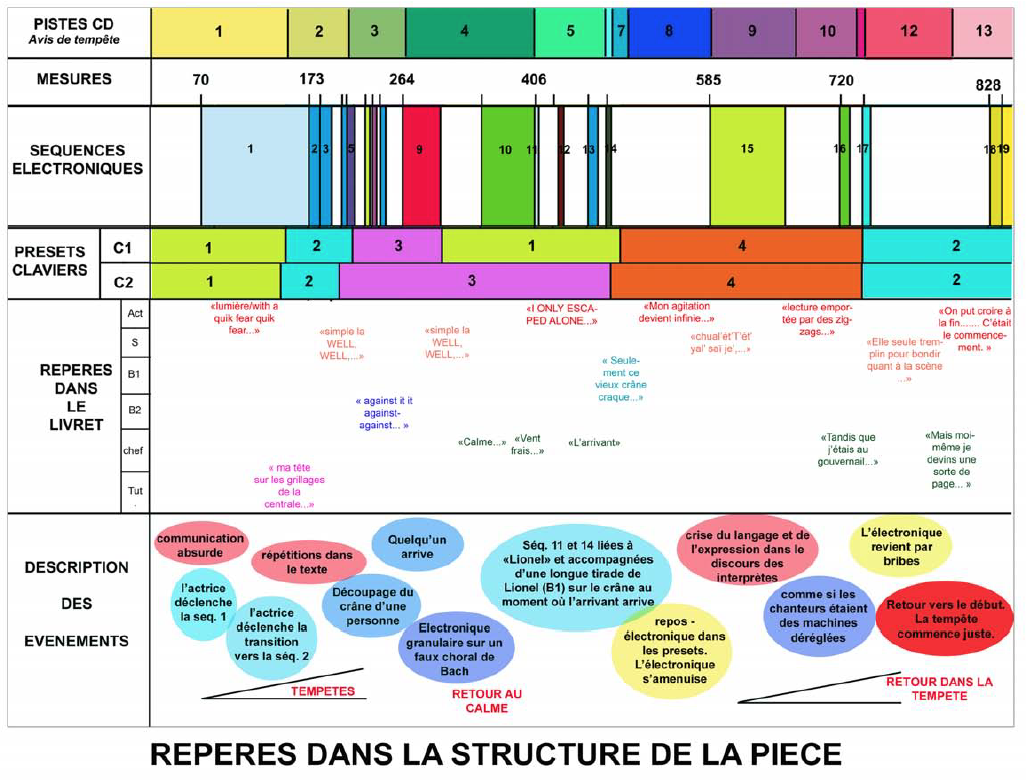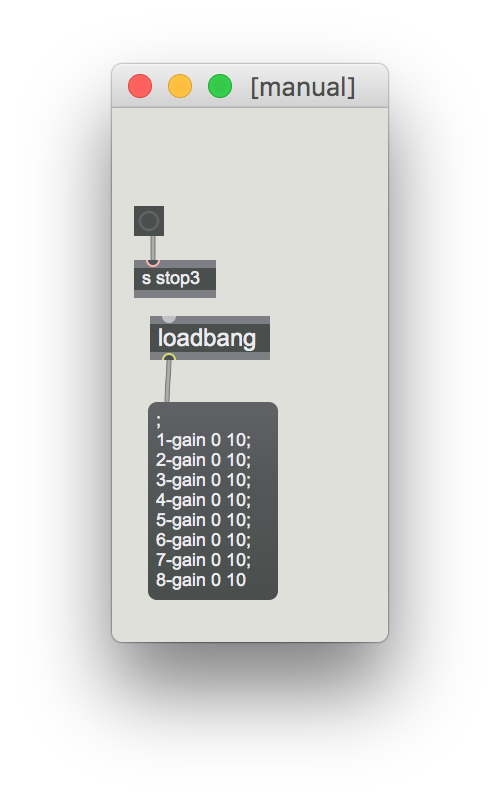Table of contents
Documentation date: 22 octobre 2018
Version state
Valid
Version documentalist
- isnard (vincent.isnard@live.fr)
Version realisation
- Sebastien Roux (Computer Music Designer)
- Emilie Morin (Assistant)
Upgrade Motivation
- This new version integrates the MIDI samples in Max (instead of using EMU E4X hardware samplers).
- Some updates were made for the compatibility with the new versions of Max. But the patches still need to be run in a 32 bits mode.
Comment
- This version is an update for a concert in Mainz in 2019.
Other version(s)
Detailed staff
- solistes : soprano solo, 2 barytons solo, danseuse (aussi actrice)
- hautbois, cor, trompette, trombone, guitare électrique, 2 autres claviers [claviers non spécifiés] , alto, violoncelle
Electronic equipment list
Computer Music Equipment
-
3 MacBook Pro - Apple Laptops
(Apple)
main + spare + conductor (= this 3rd computer is optional? see text) -
3 Max 7 - Max
(Cycling74)
-
1 samplor~ - External objects
(Cycling74)
Max Package -
2 Fireface 802 - Sound Board
(RME)
-
2 MIDI Keyboard - MIDI Keyboard
88 keys + volume pedal + sustain pedal -
1 BCF 2000 - MIDI Mixer
(Behringer)
optional? -
1 Footswitch / Sustain Pedal - Footswitch / Sustain Pedal
used by the clarinet player as a trigger to start electronic sequences -
2 Footswitch / Sustain Pedal - Footswitch / Sustain Pedal
with keyboards -
2 Volume Pedal - Volume Pedal
with keyboards -
1 MIDI interface - MIDI Interfaces
-
1 MIDI booster - Booster
Audio Equipment
-
8 Dynamic microphone - Dynamic Microphones
for instruments -
4 HF System - HF System
for singers -
8 Loudspeaker - Loudspeakers
+ 1 subwoofer -
1 Digital Mixing Desk - Digital Mixers
Work related information
Premiere
- 17 novembre 2004, France, Lille, Opéra
Publisher :
- partition téléchargeable sur le site du compositeur
Realisation
- Sébastien Roux
Work length
- 1 h 10 mn
Useful links on Brahms
- Avis de Tempête opéra, pour ensemble, trois chanteurs, une actrice et électronique (2004), 1h10mn
- Georges Aperghis
| File | Author(s) | Comment | |
|---|---|---|---|
| Download [1,4 Gio] | Patch AvisDeTempete-Oct2018 | Serge Lemouton | last corrections |
| Download [26,7 Mio] | Other Samplor Package | Serge Lemouton | To be installed into Max7 packages |
Instructions
Audio setup
INs (Mixing Desk)
- Mac 1 (main) --> RME 1 --> Mixing Desk
- Mac 2 (spare) --> RME 2 --> Mixing Desk
- Microphones --> Mixing Desk
OUTs (Mixing Desk)
- Mixing Desk --> 8 loudspeakers + subwoofer
Midi setup
- Pedals --> Keyboard 1+2 --> MIDI Merger --> MIDI Booster --> MIDI Interface 1+2 --> Mac 1+2
- Mac 1+2 (ethernet) --> Mac 3 (conductor)
Loudspeaker setup
The loudspeaker setup used at the Lille Opera House (in 2004) is shown in the following figure.

2. Launch Max/MSP in 32 bits mode (right click on Max / read the informations / check 32 bits mode).
3. Click on Options/File preferences. Then add the folder "AvisDeTempete-Oct2018".
4. Sampling rate = 44100 Hz, I/O Vector Size = 512, Signal Vector Size = 512.
5. Quit Max.
6. Launch the main patch called "tempeteV25-2018.maxpat". It corresponds to the main patch with the spatialized electronic sequences.
7. Launch the sampler patch called "AvisDeTempeteSamplors-v1.maxpat". It corresponds to the new emulated samplers for the 2 MIDI keyboards.
Patches presentation
Main patch
The main patch is composed of 2 main parts: the MIDI part (in yellow, see the following figure) and the Spatialization part (in pink and grey).
 [Fig3_MainPatch]
[Fig3_MainPatch]
The MIDI part receives MIDI information from the clarinettist pedal located on the stage. That allows the user to initialize the patch and to start a sequence if the performer has missed a cue or if the MIDI connexion is not working. It contains a patcher called georgeselie which was used during the rehearsals (in 2004).
The concert patch uses 3 players of 8 channel files. One channel of a player calls a source. Each source is spatialized thanks to a simple interface in the Spatialization part. For each sequence, a scene is stored in the patch. When the MIDI pedal is pressed, the scene is recalled and the 8 channels sequence are played.
 [Fig4_Fader]
[Fig4_Fader]
Sampler patch
The sampler patch has be designed to replace hardware samplers (in 2011) (see the following figure).
 [Fig5_SamplerPatch]
[Fig5_SamplerPatch]
The sounds are automatically loaded in the patch. Thus, it should work im/mediatly with the MIDI keyboards. During the piece, the keyboards have to choose the MIDI channel corresponding to the MIDI preset: 1, 2, 3, or 4. Each channel corresponds to a soundbank played by the keyboard, and are not always the same between the 2 keyboards (see the following figure). In the score, bar 743/744, it is notated that the keyboards should change to preset 2', it corresponds to preset 3.
 [Fig6_Structure]
[Fig6_Structure]
The outputs were set to the DACs 9-10 for the 1st keyboard and 11-12 for the 2nd keyboard, to be managed separatly in the mixing desk by the sound engineer (as in the original version with MIDI hardware samplers).
Counter patch
A "counter" patch was apparently programmed initially to give a clock to the conductor. This Max patch was described in the original documentation but was not found in the original folder with the other patches. Actually, it seems not necessary: the events are triggered by the clarinettist, and it seems that there is no need of a precise synchronization with electronics strictly speaking. However, if needed, it could be programmed and synchronized with the events thanks to the "chrono" subpatch in the main patch, where the IP address of the conductor computer can be modified to communicate via OSC.
Initialization routine
To initialize the patches:
1. In the main patch, turn the "READY" toggle on (in the MIDI yellow part).
2. Turn dsp on.
Score following
All the sequences are started by the clarinetist.
At the end of 17th sequence, the musical assistant has to stop this sequence when the keyboards start to play (cf. the following figure).
 [Fig7_ManualCue]
[Fig7_ManualCue]
Shortcuts
Space bar turns DSP on/off (be careful).
© IRCAM

This documentation is licensed under a Creative Commons Attribution-NonCommercial-NoDerivatives 4.0 International License.
Version documentation creation date: 22 octobre 2018 14:34, update date: 6 mai 2021 15:09